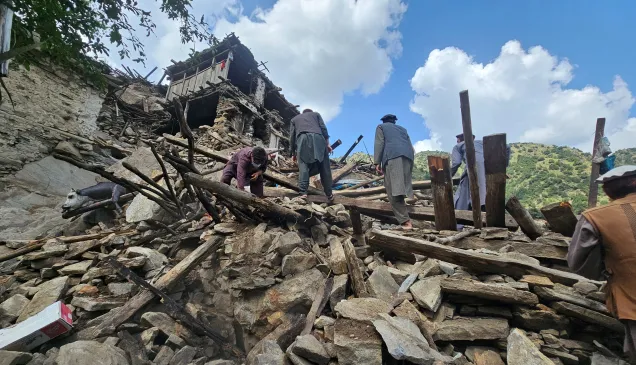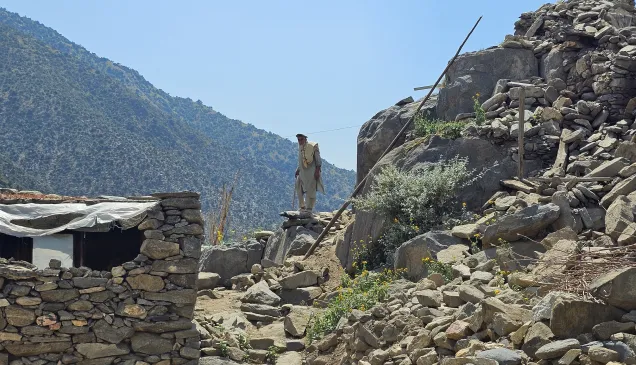Afghanistan: Four years of providing support to cerebral palsy patients

When Habiburahman, a daily wage worker from Argo district in Badakhshan, first took his children to the International Committee of the Red Cross’s (ICRC) physical rehabilitation centre (PRC) in Faizabad, he was filled with both worry and determination. His four-year-old son, Waseequllah, and one-year-old daughter, Mina Gul, were both born with cerebral palsy.
“When I first brought my children to the rehabilitation centre, one couldn’t walk and the other couldn’t even sit,” he recalled. “Now, following treatment and with the assistive devices that they were given, Waseequllah has started to walk independently and Mina Gul can sit on her own. This progress gives me real hope.”

Habiburahman with his daughter Mina Gul (in his arms) and his son Waseequllah (playing in the background) at the ICRC’s physical rehabilitation centre in Faizabad, Badakhshan.
For Habiburahman, the journey from Argo to Faizabad takes an hour and a half each way. It is a long, costly trip, but he says it is worth every effort.
Even though travelling for their treatment takes time and money, it is worthwhile. I am a daily wage worker, yet seeing my children improve makes every effort meaningful. I am truly grateful for the help we received here,
he said, smiling with hope.
Behind families like his are thousands of others whose stories reveal courage and quiet persistence. The ICRC, under its physical rehabilitation programme (PRP), aims to restore mobility and facilitate social inclusion of children and adults with cerebral palsy (CP) through seven PRCs it supports across Afghanistan. What started as only an additional service provided at these PRCs has grown into a consistent, multi-provincial network serving thousands of patients. Powerful stories of progress, resilience and hope lie behind the numbers of those assisted between August 2021 and June 2025 from the PRCs in Kabul, Herat, Mazar-i-Sharif, Gulbahar, Jalalabad, Faizabad and Lashkar Gah.
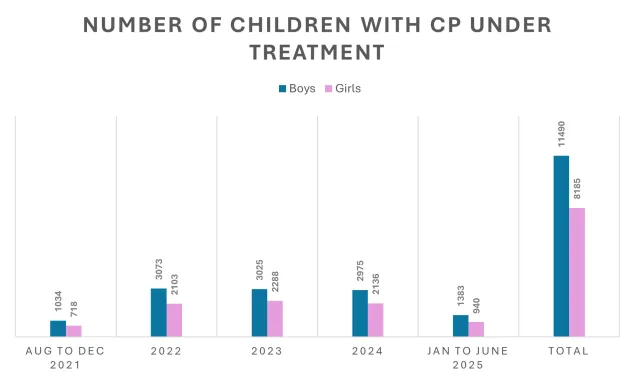
Number of Children with CP Under Treatment
According to records, children constitute the majority of those benefiting from the ICRC’s physical rehabilitation programme. Over the four-year period between August 2021 and June 2025, nearly 11,500 boys and over 8,000 girls with cerebral palsy received treatment, rehabilitation support and assistive devices in the ICRC physical rehabilitation centers (PRCs) across the country. This focus on treatment for children highlights the importance of a key strength of the programme: early intervention. Helping children at younger ages gives them the best chance to improve mobility, strengthen communication skills and participate in school and community life.
Ten-year-old Zahra from Mazar-i-Sharif is another example of how perseverance can change a life. When her mother, Abida Mohammadi, first brought her to the physical rehabilitation centre in Mazar-i-Sharif at just a year and a half old, Zahra couldn’t sit, crawl or eat on her own.
She even struggled to hold objects in her hands,” Abida remembered. “Everything was difficult for her.
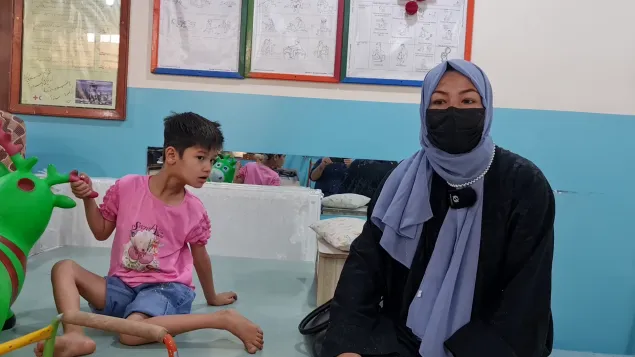
Abida Mohammadi with her daughter Zahra at the ICRC physical rehabilitation centre in Mazar-i-Sharif.
Over the years, Abida has been bringing Zahra to the rehabilitation centre every six months for therapy sessions. Guided by the physiotherapist, she carefully follows the home exercise programme recorded in a small notebook which is a daily routine that has become part of their lives. “Because of the treatment and therapy over the years, Zahra can dress herself, eat on her own, hold a pen and also write. I am so proud of how far she has come since we started coming to the centre,” she said.
Through consistent effort and care, Zahra’s progress has been notable as she achieves small milestones that her mother celebrates. Filled with hope, Abida continues to visit the centre regularly, watching her daughter grow stronger and more independent each day.
Najmuddin Helal, manager of the centre in Kabul, explains that cerebral palsy is a developmental condition that results from damage to the brain before, during or shortly after birth. “This damage can interfere with the brain’s ability to control movement and muscle function, leading to long-term challenges with coordination, muscle tone, posture and balance. In many cases, the risk of cerebral palsy increases when prenatal care is limited, as this can contribute to complications during pregnancy and delivery,” he said.
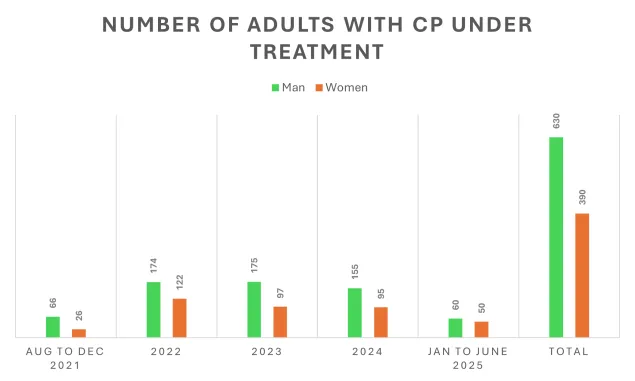
Number of Adults with CP Under Treatment
Hundreds of children and adults affected by cerebral palsy have been treated in ICRC-supported PRCs during the past four years. A total of 828 adults with cerebral palsy were registered between August 2021 and June 2025 across all provinces. Among them, 513 were male (about 62 per cent) and 315 were female (around 38 per cent). The number of new registrations rose sharply in 2022 and 2023, showing the programme’s expansion and strengthened outreach.
Social inclusion
Social inclusion programmes that integrate children and adults affected by cerebral palsy have also played a vital role in the overall rehabilitation process. Since August 2021, a total of 400 patients (257 boys, 22 girls, 106 adult males and 15 adult females) took part in activities such as futsal (indoor football), recreational therapy and other community-based inclusion initiatives.

Children playing futsal inside a gymnasium at the ICRC’s physical rehabilitation centre in Kabul.
These activities give children the opportunity to play, interact and rebuild their confidence in supportive environments. For many families, these social programmes have become as valuable as the medical treatment, helping them understand that CP is not a reason for isolation but an opportunity to adapt, connect and grow stronger together.
“The emphasis on treating children through the programme is particularly significant. The high number of treated children demonstrates that rehabilitation efforts are reaching families early, which is critical for improving long-term outcomes for children with CP,” said the ICRC’s PRC manger Najmuddin.
Support through physical rehabilitation programme in the first six months of 2025
- 104,634 patients were provided with assistance in the seven ICRC-supported physical rehabilitation centres
- 8,748 new patients were registered, including 509 people who underwent amputation
- 15,550 prostheses and orthoses were manufactured and fitted
- 72,949 physiotherapy sessions were held
- 5,311 home visits were made benefiting 2,920 patients
- 343 patients were given vocational training
- 1,534 patients were granted interest-free microcredit loans to start small businesses

